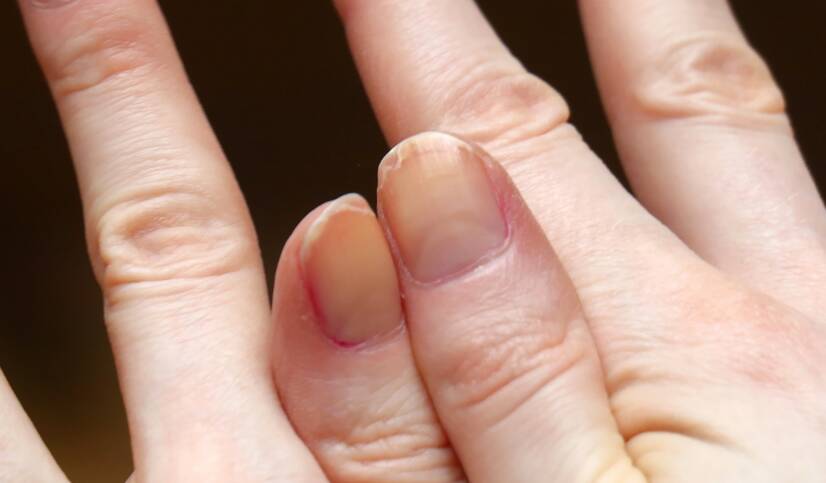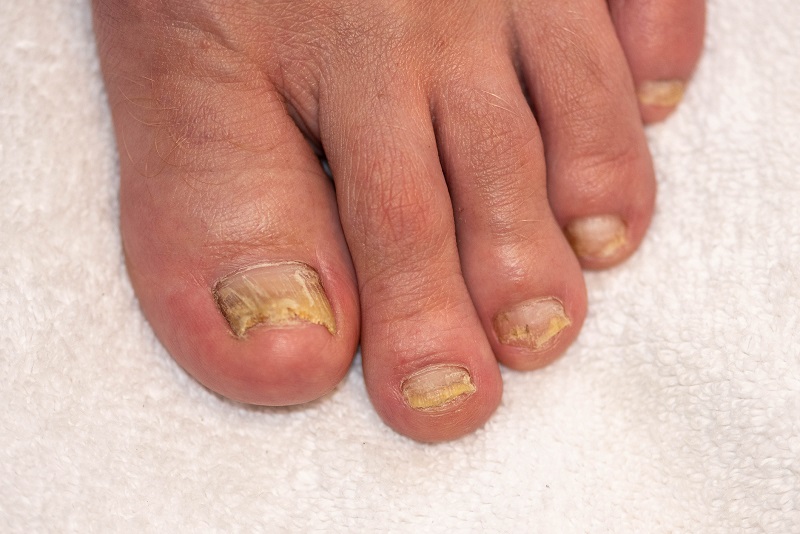- wikiskripta.eu - Nails
- npz.sk - Psoriasis can be behind ugly nails. Experts will examine you for free during the open day
- solen.sk - Mycotic skin infections
- mayoclinic.org - Nail Fungus
Yellow toenails and fingernails. Aesthetic defect or health problem?

Yellow nails are a symptom of various causes. They can be quite harmless, but they can also be a signal of illness.
Article content
Yellow toenails and fingernails send out many signals. They can reveal a lot about our lifestyle, but also about possible diseases. Therefore, yellow colouring should not be underestimated. If it is not just a cosmetic fault, it is advisable to consult a doctor about changing the nail colour.
In humans, the nail beds first form at the end of the 3rd month of intrauterine development. The nails themselves do not appear until the 7th-8th month. In premature newborns, the nails noticeably extend beyond the last links of the fingers and on the toes reach approximately to the fingertips. Nail growth in newborns is one of the signs of fetal maturity.
Interesting fact:
Besides humans and great apes, nails are also found in prosimians, but in the latter they cover the last links of only some of the fingers.
What is a fingernail?
Nails (Latin unguis, Greek onyx) are about 0.5-1 mm thick cornified plates located on the dorsal side of all the last links of the fingers of the upper and lower limbs.
On the nail plate we can distinguish:
- The visible portion - We call it the body of the nail (corpus ungius). The free margin of the nail plate (margo liber) overlaps the terminal side of the finger margin (it is whitish to translucent).
- Invisible part - The part of the nail farthest from the free margin is called the root of the nail (radix unguis). It is embedded in a deep fold of the skin and is not visible. The root and lateral margins of the nail are embedded in a skin crevice approximately 5 mm wide.
The thin, narrow strip of keratinized skin that is located on the nail plate of the visible part of the nail is called the nail cuticle (eponychium). Underneath it, a visible area of light, semicircular shape protrudes, which is called the nail crescent (lunula).
Lunulae are always visible on the thumb nail, but may not be visible on other nails.
Yellow nails. Are they a sign of fungal disease?
Healthy nails are smooth, almost as thick, slightly arched, translucent, pink in colour. The shape of the nail is influenced by heredity. It may be oval, round or square.
Fungal infections can occur on any part of the body. Fungi are normally present on our body along with other bacteria. However, when the fungus gets a suitable place and conditions to grow, it becomes infectious.
Nail fungus (onychomycosis) is a disease caused by fungal organisms. They occur naturally on our bodies. When they overgrow, mycosis results.
Nail fungus is caused by the growth of fungi on the nails, in the nails and even under the nails. Fungi thrive especially in warm and moist environments (shoes, thick socks), which make it very easy for them to multiply. However, fungi do not have to appear only on your body, we can often get them from someone else.
A warning sign of toenail fungus is just a yellow colouration.
A complete cure for this problem is a long-term affair. It is important to act as soon as you think something is wrong. Definitely do not ignore the symptoms.

Interesting information can be found in the article:
Nail mycosis, foot and nail fungus: symptoms and removal?
Nail psoriasis
Itching, pain and scaly, reddened deposits on the skin that do not go unnoticed are typical symptoms of psoriasis. However, up to half of the patients not only have skin manifestations, but also fingernails and toenails are affected.
Nail psoriasis can be a symptom of inflammation and more severe forms of psoriasis. It occurs in many patients regardless of the severity of the disease.
Most patients with psoriasis have problems with their nails. Sometimes they appear immediately and persist throughout treatment. Other times they appear and disappear again at different intervals.
A typical change in the nails is the weakening of the nail plate. This is manifested by the formation of small pits in the nail. In this way, the disease produces so-called dotted nails or oil spots - a circumscribed yellow-brown peeling of the nail plate.

ATTENTION!
Nail psoriasis is a frequent signal that the disease will also manifest itself on the joints in the form of psoriatic arthritis.
Treatment
Treatment of nail psoriasis is more difficult than treatment of psoriasis of the skin. Manifestations on the nails can be relieved in about half of the cases.
Several treatment options are known:
- Topical treatment - This is used for milder manifestations. Applying ointments and creams to the affected areas reduces inflammation, moisturizes the skin or reduces itching.
- Phototherapy - Follows when topical therapy is ineffective. It is very time consuming and requires a visit to a specialized facility.
- Systemic therapy - During this, the patient takes the therapy in the form of tablets. It is very important that the patient is monitored by their doctor and has regular blood tests to determine kidney and liver function values.
- Biological therapy - It blocks the immunological processes in the body. This slows down the progression of the disease and its manifestations.
Yellow nail syndrome
Yellow nail syndrome is a very rare disorder characterized by three areas of damage. Typical are nail malformations, airway abnormalities, and blisters from accumulated lymph. This syndrome usually affects the elderly and the cause of the disease is unknown.
A family history has occasionally been reported. A partial genetic basis is likely.
Manifestations of yellow nail syndrome
The changes occur at 3 levels:
Changes in the nails:
- Yellow discoloration.
- Disproportionate curvature of the nail.
- Almost complete cessation of nail growth
- Loss of skin
- Infection of the soft tissues around the nail
- Damage to fingernails and toenails may occur
Lung damage:
- Free fluid in the pleural space of the chest (water in the lungs)
- Chest pain, coughing
- bronchitis
- Bronchiectasis (damage and permanent enlargement of the bronchi)
- Sinusitis (inflammation of the sinuses)
- Recurrent pneumonia
Swollen lymphatic ducts:
- Upper and especially lower extremities
- Feeling of heaviness and pressure in the affected area
- Impaired mobility of the joints of the affected limbs
- Tight and hard skin under the swelling
Diagnosis and treatment of yellow nail syndrome
Diagnosis is based only on clinical manifestations and a thorough medical history.
Treatment is symptomatic due to the nature of the disease (specific problems are addressed and difficulties are alleviated). For example, antibiotics are given for respiratory problems, and corticosteroid therapy is also tried. Nail disorders can be cured without therapy, but permanent changes are rare.
Interesting:
In some people, however, yellow nails can be one of the symptoms of the disease:
- Tuberculosis
- Diabetes
- Jaundice
- Thyroid disease
- Scabies
Yellow nails. These are not always manifestations of the disease
Healthy and well-groomed nails are a very important signal in today's society. When we look at a person's hands, we immediately form an image, whether in a job interview or in everyday contact. A yellow nail colour is not always just a signal of disease. It can also be a so-called cosmetic defect.
Common causes of yellow nails include:
- Smoking - Yellow nails, but also fingers are a typical sign occurring in chronic smokers. The discoloration is caused by compounds contained in cigarettes, with which the smoker's hands are in constant contact.
- Frequent contact with chemicals - Repeated contact of the hands with certain colored chemicals (cosmetics, cleaning products, substances used in industry) can lead to discoloration of the nails.
- Painting the nails - Frequent use of nail varnishes, especially in the case of red, yellow or orange varnishes, can also cause discolouration of the nails. However, this is only a temporary manifestation without health risks, which disappears after a week.
Home nail care
One way to care for your nails is to adopt good hygiene habits.
Wash your hands regularly with warm water.
Also remember to clean the dirt under your nails to remove any potential threats.
It is important to choose the right nail polish.
Moisturize your nails and the cuticles around your nails daily.
Try petroleum jelly, olive oil, or use creams that contain lactic acid or uric acid.
Try:
If you want healthy skin and nails, try essential oils. The essential oil is made from the leaves of the tea tree. It is useful in treating nail infections.
Interesting resources
Related










